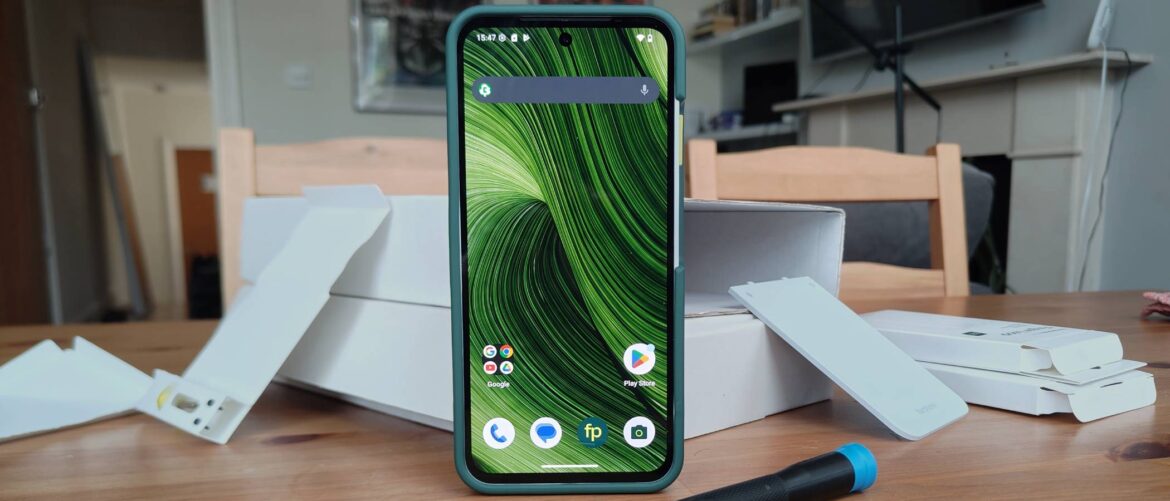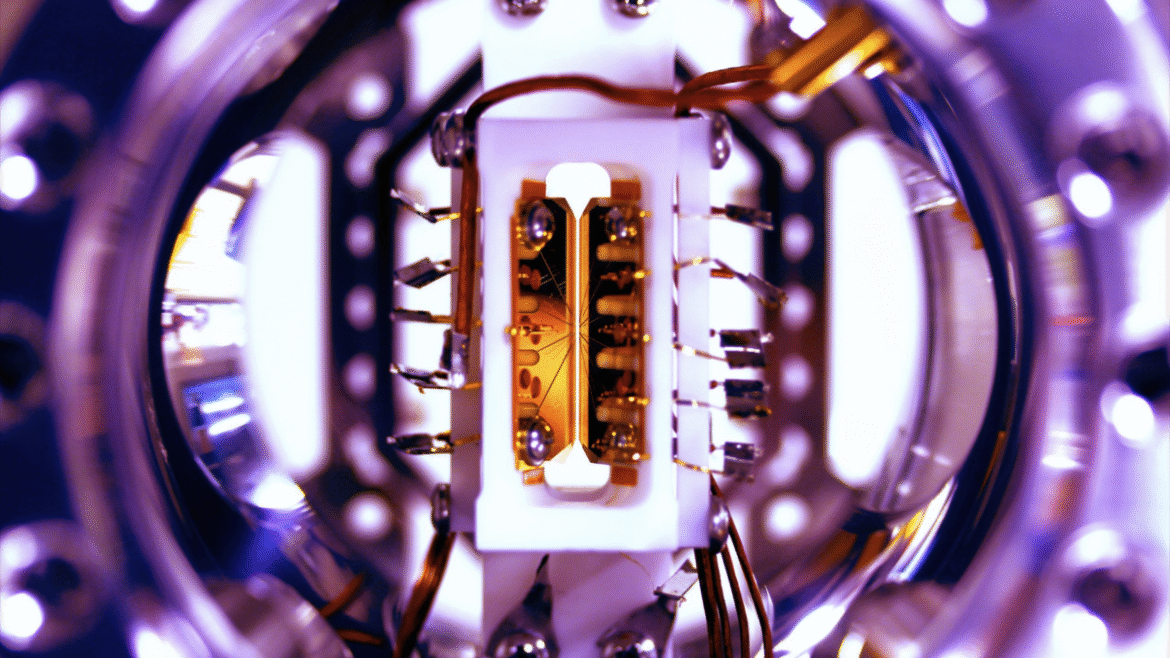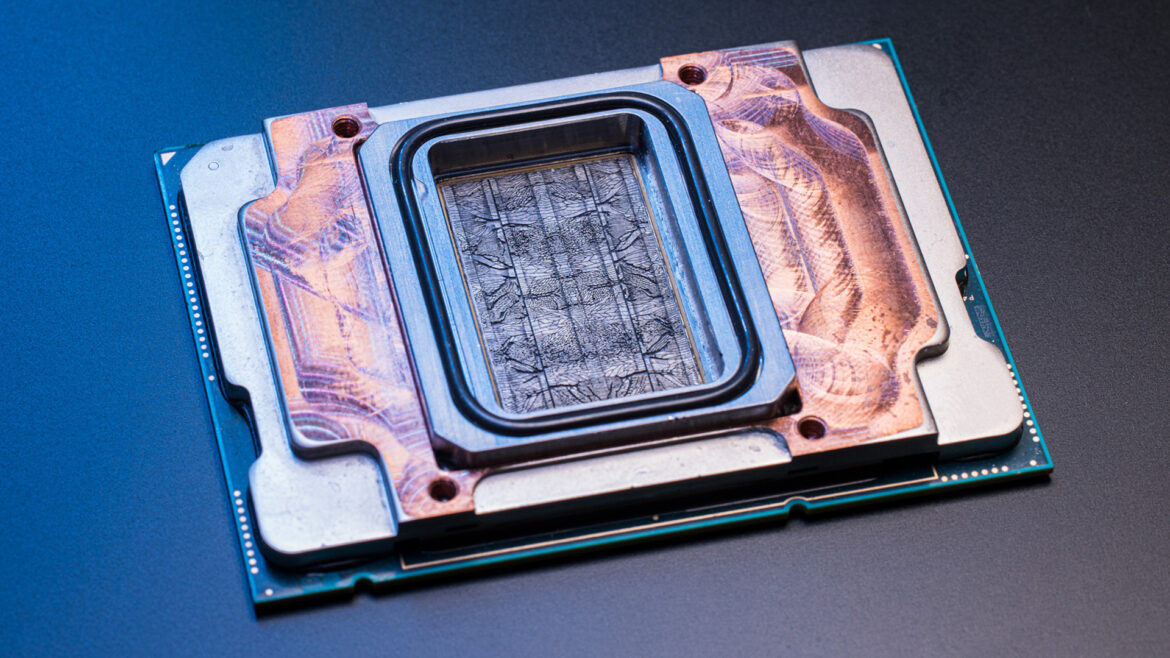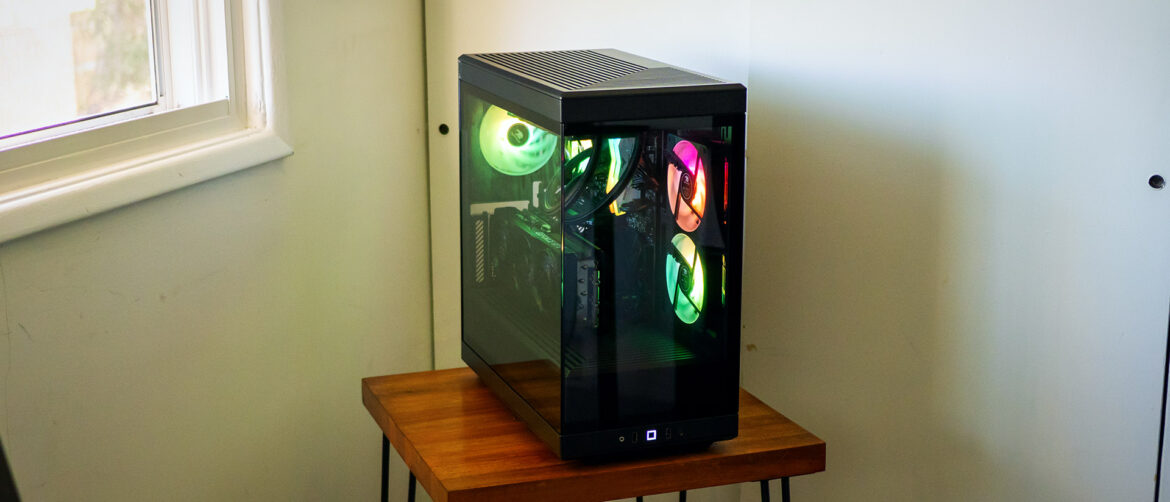Why you can trust TechRadar
We spend hours testing every product or service we review, so you can be sure you’re buying the best. Find out more about how we test.
Fairphone 6: Two-minute review
Fairphone has always delivered on its key promise of making the most eco-friendly smartphone it can, and over subsequent generations it’s also come on leaps and bounds at making a handset that’s has green credentials yet is also a solid Android phone. We’ve always given respectable reviews to handsets from the Dutch phone maker but that’s mostly for the eco-credos, and the quality of the devices has often left something to be desired.
That gets less true with each generation though and the Fairphone 6 shows another step towards the company understanding its true potential. Case in point, while this is still a chunky Android that has one foot in the rugged phone camp, it has a few features which make it stand out in the crowded smartphone market.
The successor to 2023’s Fairphone 5, the continuing key selling point for the new handset is it’s a green phone (literally, depending on which model you buy, but I’m talking about its environmental credentials). The phone incredibly easy to repair yourself, so you don’t need to toss it away should something break. It’s made with loads of recycled materials, from production processes that support fair working conditions. There’s no e-waste in the box and even the making of the phone was done with renewable energy.
While many phone brands might mutter out a line or two about how one component of its phone was made from recycled wool during an announcement, Fairphone makes its environmental mission part of the sales pitch. And with more people each year letting their carbon footprint (or desired lack thereof) inform their purchasing decisions, it remains the best part of buying a Fairphone.
But there’s more; Fairphones have often been pretty hardy but the sixth-gen model literally has military-grade certification to ensure it’s protected. I like a phone that can look after itself and you don’t need to worry with the Fairphone 6; I didn’t even put it in a case.
Like past models it’s very easy to replace damaged parts yourself using a little Fairphone-branded screwdriver, but a new change for this generation is the same process can be used to add accessories to the device (albeit ones bought separately). I found it really easy and even fun unscrewing the back panel to add a finger loop, or card holder, or lanyard, and this also encouraged me to poke around inside the device and demystify the scary-sounding self-repair process.
My biggest surprise with the Fairphone 6 was its presence of a 3D time-of-flight sensor on the back, in lieu of a third sensor. These were popular on phones a few years ago but largely as a way of bulking up a specs list, and rarely did they actually contribute much. But on the Fairphone 6, the impact is noticeable as portrait photos have incredibly accurate background blur, getting blurrier with greater distance from the subject. That’s not something you see often on smartphones and it made the Fairphone one of my favorite phones for pictures of myself (if taken on the rear camera, of course).
That’s not to say that the Fairphone is one of the best camera phones, as pictures tended to be a little dull, lacking in vibrancy and color, and the macro mode worked poorly.
Beyond the areas I’ve discussed, it’s overall a pretty average mid-range phone: its chipset, screen quality, battery capacity and charging speed are all at or slightly below what you’d expect for the price. But the software is stock Android, which provides a nice clean interface and the addition of a handy slider adds some quick functionality when you need it.
Fairphone 6 review: price and availability
(Image credit: Future)
- Announced in June 2025, released shortly after
- Costs £499 (roughly $680, AU$990) but only on sale in Europe
- Pricier version available without Android OS
After being announced in June 2025, the Fairphone 6 was put on sale across July and August, only in Europe. That’s right, Fairphone doesn’t range the phone in the US or Australia… mostly.
The handset costs £499 (roughly $680, AU$990) so it’s a mid-ranged mobile in price. The accessories Fairphone sells and you can see in review images, like the lanyard or finger grip, all cost about £25 (about $34, AU$49). For context the Fairphone 5 was quite a bit pricier at £649 (roughly $800 / AU$1,250), and the price cut is welcome.
There’s another version of the smartphones that’s ‘deGoogled’ and comes with the open-source /e/OS instead of Android as the default operating system. This costs $899 / £549 (at least AU$1,000 but there’s quite a gulf between those two prices). As you can see it is on sale in the US, although at a rather high price compared to the UK and also the European pricing.
I didn’t test this version of the phone so it hasn’t been factored into this review, but specs-wise it’s the same as the Android version of the phone.
Fairphone 6 review: specs
Here’s the spec sheet in full for the Fairphone 6:
Swipe to scroll horizontallyFairphone 6 specsHeader Cell – Column 0 Header Cell – Column 1
Dimensions:
156.5 x 73.3 x 9.6mm
Weight:
193g
Screen:
6.31-inch 20:9 FHD (1116 x 2484) 120Hz OLED
Chipset:
Snapdragon 7s Gen 3
RAM:
8GB
Storage:
256GB
OS:
Android 15
Primary camera:
50MP, f/1.6
Ultra-wide camera:
13MP f/2.2 116-degree
Front camera:
32MP, f/2.0
Audio:
Stereo speakers
Battery:
4,415mAh
Charging:
30W wired
Colors:
Green, white, black
Fairphone 6 review: design
(Image credit: Future)
- New slider for quick functions
- IP55 and MIL-STD-810H adds protection
- Easily repairable or modifable
As with past models, the Fairphone 6 is a pretty blocky handset, but it makes sense for reasons we’ll get to in a bit. It comes in white, green or black; my review unit was white but the accessories were green, hence the color clash, and I found the white model picked up marks and stains pretty easily.
The phone measures 156.5 x 73.3 x 9.6mm and weighs 193g, so it’s a little smaller than many other contemporary Androids but is pretty thick.
The bottom edge of the phone has the USB-C port but there’s no audio jack. On the left side there’s the volume rocker, which I struggled to readily reach, and replacing it on the right edge of the phone, just above the power button, is a slider.
The function of this slider can be picked from the Settings menu; you can use it to turn on Do Not Disturb, Flight Mode, Torch, Dark Mode, Battery Saver or to turn on Fairphone Moments, a stripped-back menu with quick links to the phone’s most useful functions (maps, messages etc). I personally switched it to torch, because I love it when a phone has a quick way to turn on the flashlight.
Housed in the power button is the phone’s fingerprint sensor, as the Fairphone 6 doesn’t have an under-display scanner. In testing, I found this reliable and quick to use.
The Fairphone 6 is one of the few phones that I don’t feel you need to buy a case for, as by default it feels like it’s clad in an armor of hard plastic. But there’s more; not only does it have IP55 certification against dust ingress and water, it has the military-grade MIL-STD-810H protection too. This means it’s passed tests designed by the US Department of Defense to check that it’s reliable in military situations, so it can withstand altitude, extreme temperatures, humidity, intense shocks and so on. You (hopefully) won’t need any of these protections, but it’s a useful little piece of mind so that you know the Fairphone is hardy.
The unique selling point of the Fairphone 6 is that it’s fully repairable; not by an expert or specialist but by you. If a part of your ecp-friendly phone is damaged you can easily buy a new one on Fairphone’s website and replace it with a screwdriver (the company’s video tutorials might help), saving you buying a whole new device if one component is damaged. This is that eco ethos in action.
It’s also the case with accessories, as you can remove the phone’s back panel and replace it with a card holder, a finger loop or similar. The ability to be easily modded like this is perhaps the Fairphone 6’s most distinct upgrade over its predecessor and, frankly, is pretty fun to do too (Fairphone sent me each of the accessories along with the phone, though they’re not included in-box).
Fairphone 6 review: display
(Image credit: Future)
- 6.31-inchd display feels small compared to contemporaries
- New refresh rate at 120Hz beats predecessor
- Sometimes struggles in sunlight
Compared to the behemoth screens of some flagship Android phones, the Fairphone 6 might feel a bit small (or ‘compact’, which is the diplomatic word choice). The display measures 6.31 inches across, so it matches the iPhone 17 in this regard.
The resolution is 1116 x 2484, just a hair above FHD+, and it has a 120Hz refresh rate in a notable upgrade over the last-gen Fairphone. The max brightness is 1,400 nits which is fine, but not as bright as many rivals, and I wouldn’t have minded a bit of extra shine for use on sunny days.
Most of the time, though, the Fairphone 6 display works well, especially since it totes the same number of pixels as a much bigger display but crammed down into a smaller screen to increase the pixels-per-inch count.
Fairphone 6 review: software
(Image credit: Future)
- Comes with stock Android 15
- 7 years of updates
- Fairphone app gives extra insight into phone
Fairphone is one of the few remaining companies to use ‘true’ stock Android – not an Android fork, and not stock Android buried under so many customizations that it feels like a fork anyway.
In the case of the Fairphone 6 that means you’re looking at Android 15, and all the features that come with it: live location sharing, dodgy text warnings, screen time tracking and so on. The handset is due to get upgrades for the next seven years, which would take you up to Android 22 in the year 2033 (if that’s what Google decides to call it).
If you like a clean interface with no added bells and whistles, you’ll like the Fairphone 6’s software. You start free from bloatware and can build up your app library just how you like it.
Fairphone does have one addition: its own app is included on the device at start, and while you can remove it, there are some useful features. Firstly, it lets you find information about the device at a tap, instead of buried away in the Settings menu (although mine told me I had 0GB RAM and 0GB storage, perhaps an issue with a review unit. It lets you buy spare parts and accessories quickly too, providing video tutorials on how to add or replace parts.
But the most important is a phone health option, so you can see how much memory and storage you’ve used up, and also what the phone’s temperature is, giving you a little insight into its operations. The benefit of this is for the device’s longevity, so you can keep it ticking longer.
Fairphone 6 review: cameras
(Image credit: Future)
- 50MP main and 13MP ultra-wide cameras, 32MP up front
- Pictures lack contrast and color, but are detailed
- Rear portraits look really good
Judging by a look at the specs list, Fairphone 6 isn’t being dragged into the camera- sensor pixel wars, dropping many from the past model. Its main camera is a 50MP f/1.6 snapper and it’s joined by a 13MP f/2.2 ultra-wide as well as a 3D time-of-flight sensor. Those specs are absolutely fine for a low-cost phone (except the TOF sensor, a relic of yesteryear, which nine times out of ten doesn’t contribute anything) but nothing to write home about.
Photos taken on the phone are… fine. Forgive the boring descriptor but it’s the most apt one. Snaps have lots of image quality but not much in the way of dynamic range, with a single cloud in the sky dooming the photo with a noticeable lack of color or vibrancy.
In well-lit scenarios things fared a little better, but only a little; the greens of a natural landscape blur into one and a little extra contrast would go a long way. Still, they’re fine-looking for sharing around, especially if you don’t mind going into the edit menu and sprucing them up a little.
Fairphone’s mobiles have rarely had much in the way of photo post-processing optimization, at least compared to competitors, and that’s the case again. It won’t impress anybody but this is a phone for saving the planet, not for capturing sparkly pictures flaunting all the air miles you’ve burned by going to a remote beach for your holiday.
(Image credit: Future)
On the front there’s a 32MP f/2.0 camera for snapping selfies and I generally found it pretty fit for purpose, if still indicative of the rear cameras’ issues; snaps could be a little washed-out and colorless.
For a brief whip around the other specs: you can record video at 4K at 30fps or 1080p at 60fps, and down to 120fps at 1080p in slow-motion mode. Most of the other modes are ones you expect: Pro, panorama, time-lapse and night mode.
There are two modes I’ll flag. First is portrait, with the Fairphone 6 surprisingly touting one of the best iterations of this mode I’ve seen. While snaps weren’t exactly vibrant, the bokeh background blur was accurate and varied in intensity depending on the distance to the phone, which is something I rarely see; that could be the TOF sensor in effect.
The other mode is macro, which really didn’t work too well. Like on most phones without a dedicated macro lens it uses the ultra-wide one, resulting in a pixel-heavy pic, missing the depth of field that such pictures should have. In testing I always turned off macro mode and relied on the main camera for such shots instead.
Fairphone 6 camera samples
Image 1 of 11
A standard picture taken on the Fairphone, in fairly well-lit conditions.(Image credit: Future)An ultra-wide photo taken in overcast conditions, to contrast the following two snaps.(Image credit: Future)A standard photo taken in overcast conditions, to contrast the preceding and following snaps.(Image credit: Future)A 2x zoom snap taken in overcast conditions, to contrast the two previous snaps (the phone uses digital zoom).(Image credit: Future)A canape board taken at 1x zoom in artificial lighting at close range.(Image credit: Future)A portrait snap of a man to show the bokeh effects (white bars added manually before adding this picture to the web).(Image credit: Future)A macro picture of some flowers… or an attempt to photograph them.(Image credit: Future)The flowers from the previous photo, but using the main camera, to show how improved it is.(Image credit: Future)Another standard picture of a closer object.(Image credit: Future)Another standard photo of a further subject.(Image credit: Future)A final standard photo showing a woodland scene with mixed lighting.(Image credit: Future)
Fairphone 6: performance and audio
- Mid-range Snapdragon 7s Gen 3 chipset
- Single 8GB/256GB model
- Bluetooth 5.4 or USB-C port for audio, no jack
As is the way with Fairphone’s mobiles, the Gen 6 doesn’t have a top-end chip, but it has enough power that you won’t find it too slow for everyday use. The chipset here is the Snapdragon 7s Gen 3, which we’ve also seen in the likes of the Nothing Phone 3(a) Pro and Xiaomi Redmi Note 14 Pro Plus.
This is a mid-range piece of kit, capable of handling gaming in a mostly fine fashion, though maybe not at the top graphics options if you don’t want stutters, and all everyday tasks.
When I put the phone through a Geekbench 6 benchmark test, it returned a multi-core average score of 3,430, which reflects the chipset; Snapdragon 600s often sit at around 2,000 points while 800s I’ve tested recently have gone to the mid 4,000s.
Paired with the chipset is 8GB RAM and 256GB storage, and there’s only one configuration available. While 8GB RAM is nothing to write home about, a spec that flags this as a mobile not designed for power-users, the storage is a solid amount that compensates for the lack of a microSD card slot.
It’s 2025 so of course there’s no 3.5mm audio jack for audio, Fairphone ditched that years ago when everyone else did. Instead you can listen to music using the Bluetooth 5.4 support or using a USB-C adaptor. The stereo speakers aren’t exactly impressive but that’s normal for a smartphone.
- Performance score: 3.5 / 5
Fairphone 6 review: battery life
- Relatively slender 4,415mAh battery
- Slow 30W charging
(Image credit: Future)
The Fairphone 6 has a 4,415mAh battery, one which the company estimates will keep you going for “almost two days” from 100% power. I wouldn’t go that far, and I’d put the lasting power at about a day, or a little bit longer if you’re not an intensive user.
That’s a fine battery life for a smartphone, even if 4,415mAh may seem anemic given that most contemporaries have pushed it to 6,000mAh. Fairphone’s own optimizations and software and spec choices often counter smaller-capacity batteries.
Of course, if your battery starts to diminish or go wrong, it’s one of the many parts of the phone you can swap out very easily.
Charging is done at 30W, which is again a little lower than rivals, and you’ll have to wait for well over an hour to get from empty to full. There’s no kind of reverse or wireless powering.
Fairphone 6 review: value
(Image credit: Future)
What price would you put on a phone that looks after the planet?
Rhetoric aside, the Fairphone 6 isn’t priced particularly competitively when you look at the specs, but what sets its apart is its lasting power.
Not only does its IP and military certification ensure it’ll survive damage much better than other handsets on the market, but the fact you can replace ailing parts ensures that the mobile’s lifespan will far outstrip anything else you might be considering.
After all, the average phone lasts for under three years, especially cheaper models. The Fairphone 6 will last you longer than multiple other models if you let it.
Should you buy the Fairphone 6?
(Image credit: Future)Swipe to scroll horizontallyFairphone 6 score card
Attributes
Notes
Rating
Value
The potential lasting power of this phone means its price seems like a bargain, when looking at the bigger picture.
4.5 / 5
Design
It’s no looker, but it’s well protected, easily modifiable and has a handy new slider.
4 / 5
Display
If you want a phone with a smaller screen, the Fairphone will fit you perfectly.
3.5 / 5
Software
The software is nice and clean, as Google intended, but without the extra features Android forks bring.
3.5 / 5
Camera
Other than the impressive portrait capabilities, the Fairphone 6 cameras are bang average.
3.5 / 5
Performance
The Snapdragon chip here is fine for everyday use for most people, but gamers will pine for more.
3.5 / 5
Battery
The battery is small and the charging slow, but optimizations ensure the actual battery life is okay.
3.5 / 5
Buy it if…
Don’t buy it if…
Fairphone 6 review: Also consider
If you don’t think this mobile is right for you, let’s look at some similar-priced handsets. Just note, other than the first, these won’t retain the Fairphone’s green principles.
Swipe to scroll horizontallyHeader Cell – Column 0
Fairphone 6
Fairphone 5
Xiaomi Redmi Note 14 Pro Plus
Nothing Phone 3a Pro
Starting price (at launch):
£499 (roughly $680, AU$990)
£649 (roughly $800 / AU$1,250)
$399 / £399 (roughly AU$800)
$459 / £449 / AU$849
Dimensions:
156.5 x 73.3 x 9.6mm
161.6 x 75.8 x 9.6mm
162.53 x 74.67 x 9.95mm
163.52 x 77.5 x 8.39mm
Weight:
193g
212g
210g
211g
OS (at launch):
Android 15
Android 13
Android 14, HyperOS
Android 15, NohtingOS 3.1
Screen Size:
6.31-inch
6.46-inch
6.67-inch
6.77-inch
Resolution:
1116 x 2484
2700 x 1224
2712 x 1220
1080 x 2392
CPU:
Qualcomm Snapdragon 7s Gen 3
Qualcomm QCM6490
Qualcomm Snapdragon 7s Gen 3
Qualcomm Snapdragon 7s Gen 3
RAM:
8GB
8GB
8GB / 12GB
12GB
Storage (from):
256GB
256GB
256GB / 512GB
256GB
Battery:
4,115mAh
4,200mAh
5,110mAh
5,000mAh
Rear Cameras:
50MP main, 12MP ultra-wide
50MP main, 50MP ultra-wide
200MP main, 8MP ultra-wide
50MP main,. 50MP zoom, 8MP ultra-wide
Front camera:
32MP
50MP
20MP
50MP
How I tested the Fairphone 6
(Image credit: Future)
- Review test period = 2 weeks
- Testing included = Everyday usage, including web browsing, social media, photography, video calling, gaming, streaming video, music playback
- Tools used = Geekbench 6, Geekbench ML, GFXBench, native Android stats
I tested the Fairphone 6 for just over two weeks to write this review, using it as my normal mobile in this time. As stated, I was sent the white version of the mobile along with all the extra accessories.
The testing process included a mix of experience and ‘lab’-style, so I’d use the handset as my normal phone for some of the time but also conducted a battery of benchmarking tests as well. I also took the phone with me on holiday, hence the camera samples.
I didn’t test the military-standard protection of the phone, due to not having a nearby warzone or extreme climate in which to do so. I’ll have to take Fairphone’s word for that.
As well as this mobile, I’ve tested the last few Fairphone mobiles, alongside plenty of other devices since I started reviewing for TechRadar in early 2019.
Read more about how we test
First reviewed September 2025










